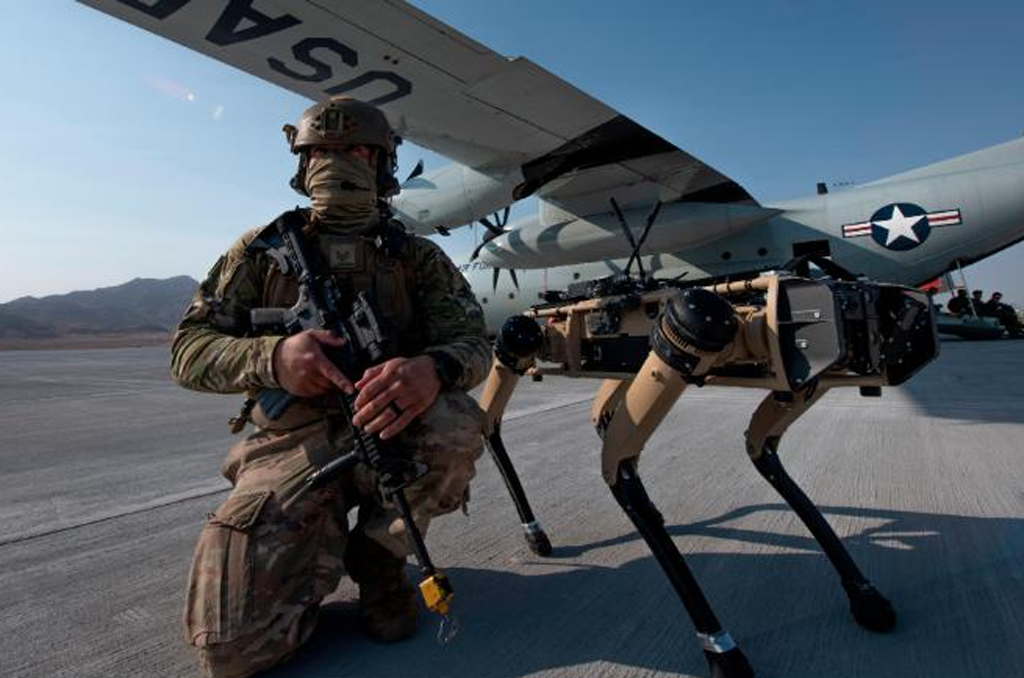Courtesy: (U.S. Air Force photo by Tech. Sgt. Cory D. Payne)
The 325th Security Forces Squadron is enlisting some dog patrolling support at the Tyndall Air Force Base in Panama City, Fla.
The dogs will cost around $100,000 each and can roam around the bases’ perimeter for roughly seven-mile round-trips before being charged.
If you haven’t noticed by now, these are not ordinary pet shops or shelter dogs, and they are VERY expensive. The dogs are weatherproof, four-legged, unmanned patrolling drones with two-way communication and high-tech sensors.
The “robo-dogs” will be adding a presence that confirms Tyndall’s pledge to become the “base of the future” and will become the first military base to use such technology for enhanced security and surveillance patrolling in the country.
“This is a springboard into the future of integrated defense,” said Squadron Commander Maj. Jordan Criss at a “robo-dog” demonstration on base. “This is only the first step, and what we’re very excited to do is be that test and evaluations site which proliferates the rest of this technology for the rest of the Air Force.”
The base will deploy four of the fully robotic, four-legged patrollers to act as sentries around the base’s perimeter.
The drones come courtesy of Ghost Robotics out of Pennsylvania and have been in development for over 10 years.
“We had a concept to create kind-of a warfighter protection system, so really a replacement for a live dog,” said Jiren Parikh, CEO of Ghost Robotics. The robots were created to mitigate and lessen human, animal, and heavy asset losses, Parikh added.
“They’re not there to hurt anybody; they are there to be an extra set of eyes and ears for our defenders,” Maj. Criss said. “They can do in-depth terrain analysis and enhance the situational awareness for our defenders.”
The watch dogs can roam on their own or be manually operated.
Parikh also highlighted that while the robots don’t “bite,” if someone attempts to steal or “harm” the robot that they have a flailing reaction that, if kicked by, will hurt.
While the robo-dogs aren’t expected to begin patrol on base until February 2021, Maj. Criss is excited to see what the future holds and how they can use these sentries in the military moving forward.
“We’re super appreciative of being the test-bed and being able to step-through working with this technology. “These robots can again do things that the human brain and the human person can’t do, which allows the human being to enhance their response and their capabilities.”
About Ghost Robotics
Ghost Robotics® is revolutionizing legged robotics and the market for highly-agile and fast tele-operated and autonomous unmanned ground vehicles (UGVs) for military, homeland security, public safety, and enterprise applications. Our quadrupedal UGVs (Q-UGV®) are unstoppable.
Beyond all-terrain stability and operation in unstructured environments, a core design principle for our legged robots is reduced mechanical complexity when compared to other legged robots, and even traditional wheeled-tracked UGVs. By reducing complexity, we inherently increase durability, agility and endurance, and reduce the cost to deploy and maintain ground robots. Our modular design supports field maintenance and parts replacement within minutes. Strategic partners can build solution-specific Q-UGVs for virtually any use-case with their choice of sensors, radios and even size the robot to suit specific requirements by licensing our reference designs.
For more stories like this, Florida Insider is your source for all things Florida. From business to nature, to sports and more, we have it all. Easy to read content at the palm of your hands and covering stories that matter.

